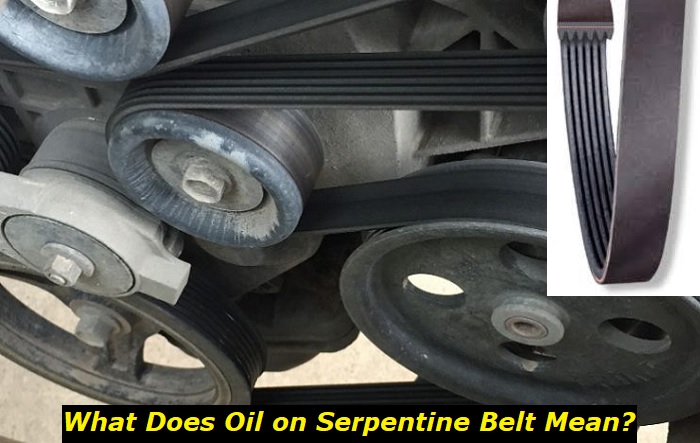Your serpentine belt in the car is really important for the operation of the vehicle. It's also known as the drive belt because it drives a lot of important elements and units in your vehicle. When it fails or breaks, problems may be too bad, especially if you are driving on a highway and speeding up like crazy. But what to do when you see drops or lines of oil on the drive belt?
Oil leaks highlights
- Level of urgency:medium
- Average mileage:over 50,000 miles
- Repair cost:$200 - $1,800
- DIY repair:only in some cases
- Commonreasons:head gasket, other gaskets, seals, fasteners
- If ignored:low engine oil level, contamination of units under the hood, engine damage
- How to solve:locate the leak and repair the system that is leaking

What's the serpentine belt and why is it so important?
Your engine may have one or two belts depending on its construction. The timing belt or chain is hidden and you can't inspect it easily. While the serpentine belt is usually visible to anyone who opens the hood. You will still need to try and bend your back to see the belt in modern cars that have a lot of plastic covers hinting to you that there is nothing much you can do under the hood of your car.
So, here are the main tasks of the drive belt in your car engine:
- it is driven by the engine, so when the engine rotates, the belt works and delivers torque to some important components of the vehicle's system;
- one of its main tasks is to drive the alternator that supplies all electrical units of your vehicle with power and charges the battery;
- also, the drive belt usually drives the hydraulic steering system (if your vehicle has the hydraulic one, not electric);
- one more task of the belt is to drive the air-conditioner compressor to allow you to control the air temperature inside the vehicle;
- the belt has its own system of stretching compensation but it only functions as the support system for this belt.
Now you know what tasks the serpentine belt has in your car. And these tasks are pretty important. The belt is not eternal, however. It can wear because of natural reasons like age and mileage. But it can also break because of some unusual loads or harsh conditions. For example, when one of the bearings is blocked, the alternator is stuck, or the power steering is malfunctioning.
Once it breaks or stretches, the belt can't do its job anymore and the vehicle is basically paralyzed. It can still go some time using power from the battery, but this will not be long. And the steering wheel will become heavy as hell, too, making it not that safe to drive your vehicle.
What are the immediate symptoms of a broken serpentine belt?
- The battery pictogram flashes on the dashboard of your vehicle.
- The steering wheel becomes too heavy to turn (for hydraulic steering systems).
- The AC stops working and the fan blows in just hot air.
- The battery dies and the voltage in the car system goes down significantly.
- The vehicle may stall because of low voltage.
- You can hear strange noises from under the hood.
- You don't see any belt where it usually is.
- The belt is still there but looks damaged.
Why can oil be there on the serpentine belt?
Now, the very important question is where can oil leak and get directly to the serpentine belt. This is a very common issue when people open their car's hood and see that the drive belt is greasy - it has some black spots or lines on it which resemble oil. This may be too bad for the belt and it's great that you've decided to read this article before making any conclusions.
So, first of all, it's important to understand if the oil is fresh or not. It can be old and dry. This is still bad, but you may at least drive to your favorite repair shop and have the vehicle diagnosed without any risks.
If there are a couple of drops of oil, even fresh ones, you can still drive. But be careful and listen to any noises from under the hood. If you hear anything strange, stop the vehicle and turn off the engine.
If the belt is all greasy and covered with fresh oil, the best solution is to stop driving your car until you find the reason for this.
Here are the possible sources of oil on your drive belt:
- engine head - it's usually located right above the belt and the gasket may leak sending some oil right onto the belt;
- power steering - the steering system has some lubricant inside, so it can also grease the belt if it has some leaks which is not that uncommon;
- turbocharger - the turbo is one of the most common places where the oil leak may occur, so it's worth checking in the first place;
- engine crankshaft - this unit drives the serpentine belt and so it may also leave some oil on it if the seal is leaking;
- unexpected parts - some drops of oil may come from the steering rack or from basically any other unit under the hood.
So, checking up on the source of oil on the drive belt is not that easy. You will need to take apart half of all those plastic covers and other things to see the part that leaks. But doing this on your own is not recommended unless you have experience repairing car engines. Otherwise, you may struggle to assemble all those parts back.
Also, what will you do when you discover the part that is in charge? The best solution is to have the vehicle diagnosed by the specialist as soon as possible.
Why should oil on the serpentine belt alert you?
This is a bad sign because the belt can quickly wear out, break, or just start slipping. Belts shouldn't be greased with oil because they will start slipping. The drive belt has no teeth to hold on to the pulleys. Instead, it has longitudinal grooves that help it get all the mechanisms working. These grooves may slip easily if they have some oil on them. You will hear a loud whistling noise when this happens.
But the worst thing is that belts are made of materials that shouldn't be covered with oil. They can deteriorate quickly, become too soft, and stretch too much. This will lead to immediate problems with your vehicle. Also, after replacing the serpentine belt, you may still experience problems with the car because the pulleys and tensioners are still covered with a little oil. And they should be cleaned now.
Here's what you should do if you find some oil on the drive belt
- Turn off the engine and see if the oil is fresh.
- If it is, try to locate the unit that leaks and lubricates the oil.
- According to the info you already know, decide if you can drive further.
- Plan your visit to the repair shop or to the dealer as soon as possible.
- Have the problem diagnosed and sorted out by professionals.
How expensive it is to repair a vehicle with an oily serpentine belt?
Any repair is pretty expensive. Labor costs some money, so even to diagnose the issue, you will need to invest some dollars. But, in most cases, this is not going to be super expensive. First of all, it depends on whether you need the new belt. Also, it depends much on which part leaks oil. If it's all about head gasket failure, this is going to cost you a fortune because for replacing this part you will need to take apparat half of your engine.
If you need to replace the power steering system because of leaks, it will also cost you a lot of money. Parts are expensive and a lot of work should be done, too.
So, it may cost you anywhere from $100 to $3000 depending on what exactly has to be repaired. Unfortunately, we can't give any further details about the price until we know the exact diagnosis.
Final words
Now you know that if you see some drops or lines of oil on your serpentine belt, this should alert you and make you plan your next visit to the repair shop as soon as possible. The problem may be really bad because of the issues with the belt itself and also with the units that may cause oil leaks. You should locate the problem and fix it as soon as you can because it can result in much worse problems than just a greasy drive belt.
About the authors
The CarAraC research team is composed of seasoned auto mechanics and automotive industry professionals, including individuals with advanced degrees and certifications in their field. Our team members boast prestigious credentials, reflecting their extensive knowledge and skills. These qualifications include: IMI: Institute of the Motor Industry, ASE-Certified Master Automobile Technicians; Coventry University, Graduate of MA in Automotive Journalism; Politecnico di Torino, Italy, MS Automotive Engineering; Ss. Cyril and Methodius University in Skopje, Mechanical University in Skopje; TOC Automotive College; DHA Suffa University, Department of Mechanical Engineering






Add comment